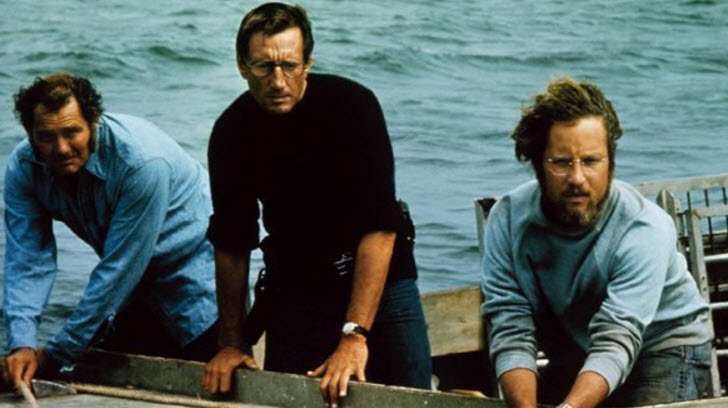Everything started with the disappearance of a skinny-dipping blonde off the coast of Amity Island in coastal New England. Amity’s Chief of Police Martin Brody, played by Roy Scheider, had perhaps the second biggest boat for those whose careers were launched in the 15th movie on our Top 20 Movies in ranked order listing, Jaws (1975).
The movie Jaws offered perhaps the biggest career boost to highly influential producer, writer, director, and actor Steven Spielberg. At the time that Jaws was do to be made, Spielberg undoubtedly was on the rise. He was selected to direct the cinema worthy of the marketing buzz created for Peter Benchley‘s 1974 book Jaws. As the Turner Classic Movie (TCM) telling informs us, producers Richard D. Zanuck and David Brown had acquired rights for producing a movie from Benchley’s book. Spielberg, who has earned much influence in the film industry, was their directorial choice.
We as the audience get to know Amity police chief Martin Brody (Roy Scheider) best. Much of Jaws is told from Brody’s perspective, and we wind up rooting for him as the hero.
Brody is pitted against two primary antagonists.
The first and obvious antagonist is the main attraction…the Great White Shark that brought people to the movie theater. Perhaps the iconic quote of the movie comes when Jaws (the shark) is battling Brody and fellow protagonist, boat-owner, and seaman Quint (played by Robert Shaw). Brody spoke the quote to Quint:
“You’re gonna need a bigger boat.”
I personally admire the popularity and resonance of the quote, in addition for the context that prompted it. Part of that context is the second main antagonist. Amity Island’s money-obsessed, safety-last Mayor Larry Vaughn, played by Murray Hamilton, partially responds to outside pressure from the business community in advocating for maintaining an open beachfront around the lucrative Independence Day timeframe. After all, this middle-of-summer period is when people travel to the tourist town of Amity Island for sand, water, lodging, and tourism.
In the midst of this, and after the death of the skinny dipping lady to start the movie, a boy is attacked by the shark we know to be Jaws. Richard Dreyfuss plays Matt Hooper, an oceanographer fascinated with sharks who hired Quint to hunt and kill that shark that had staked a claim to Amity Island.

The building tension and focus on the main story line of the killer shark, the reluctant mayor, and the struggle to kill a shark swimming around Amity Island is aided by a famous soundtrack created by renowned composer John Williams. In providing the compelling theme song to Jaws, Williams‘ music is as much of a character in the movie as the characters, the tension, and the shark.
In the heat of the fight to close the beach, the film Jaws and its director (Spielberg) are given a tip of the cap in the naming of Bryan Singer’s production company. Chief Brody responds to an elderly gentleman teasing Brody for not going in the water. As Mental Floss explains, the elderly man is Harry, he is wearing an ugly swimming cap, and the line itself is this:
“That’s some bad hat, Harry.”
Bad Hat Harry Productions goes on to produce House M.D. (2004-2012) and The Usual Suspects (1995).
Steven Spielberg has won Academy Awards for Best Director for Saving Private Ryan (1998) and Best Picture and Best Director for Schindler’s List (1993). He also won Best Director Golden Globes for both of those films.
As we are reminded by this Five Thirty Eight article, the opening of Jaws (1975) in June of that year is considered “the beginning of the era of the Hollywood summer blockbuster.” If you haven’t already seen this movie, you really should.
Matt – Friday, February 10, 2017

